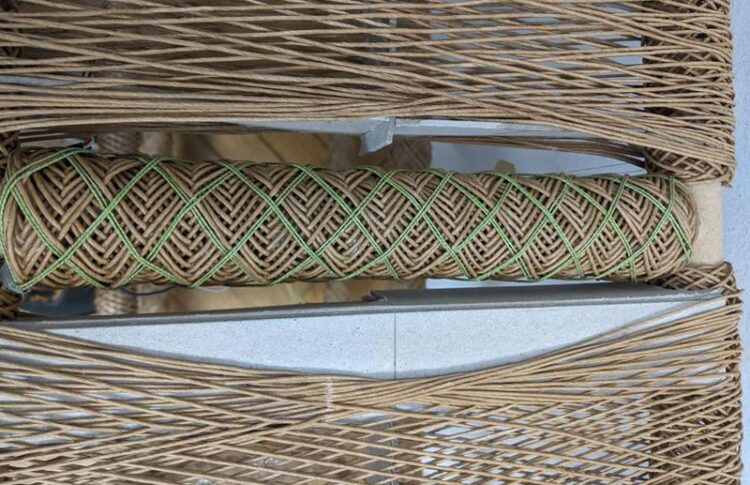Recyclable event and trade fair furniture made of paper

Structurally wound paper yarn element with green sensor yarn
(c) DITF
A lot of waste is generated in the trade fair and event industry. It makes sense to have furniture that can quickly be dismantled and stored to save space – or simply disposed of and recycled. Paper is the ideal raw material here: locally available and renewable. It also has an established recycling process. The German Institutes of Textile and Fiber Research (DITF) and their project partners have jointly developed a recycling-friendly modular system for trade fair furniture. The “PapierEvents” project was funded by the German Federal Environmental Foundation (DBU).
Once the paper has been brought into yarn form, it can be processed into a wide variety of basic elements using the structure winding process, creating a completely new design language.

Pyramid-shaped display and illuminated counter. (c) DITF
The unusual look is created in the structure winding process. In this technology developed at the DITF, the yarn is deposited precisely on a rotating mandrel. This enables high process speeds and a high degree of automation. After the winding process, the individual yarns are fixed, creating a self-supporting component. A starch-based adhesive, which is also made from renewable and degradable raw materials, was used in the project for the fixation.
The recyclability of all the basic elements developed in the project was investigated and confirmed. For this purpose the research colleagues at the project partner from the Department of Paper Production and Mechanical Process Engineering at TU Darmstadt (PMV) used the CEPI method, a new standard test procedure from the Confederation of European Paper Industries.
Sensor and lighting functions were also implemented in a recycling-friendly manner. The paper sensor yarns are integrated into the components and detect contact.
Also, a modular system for trade fair and event furniture was developed. The furniture is lightweight and modular. For example, the total weight of the counter shown is well under ten kilograms and individual parts can easily be shipped in standard packages. All parts can be used several times, making them suitable for campaigns lasting several weeks.
A counter, a customer stopper in DIN A1 format and a pyramid-shaped stand were used as demonstrators. The research work of the DITF (textile technology) and PMV (paper processing) was supplemented by other partners: GarnTec GmbH developed the paper yarns used, the industrial designers from quintessence design provided important suggestions for the visual and functional design of the elements and connectors and the event agency Rödig GmbH evaluated the ideas and concepts in terms of usability in practical use.
Wissenschaftliche Ansprechpartner:
Further information: Viola Finckh
Technology Center Smart Living Textiles
P +49(0)711 9340-629
E viola.finckh@ditf.de
Media Contact
All latest news from the category: Ecology, The Environment and Conservation
This complex theme deals primarily with interactions between organisms and the environmental factors that impact them, but to a greater extent between individual inanimate environmental factors.
innovations-report offers informative reports and articles on topics such as climate protection, landscape conservation, ecological systems, wildlife and nature parks and ecosystem efficiency and balance.
Newest articles

A universal framework for spatial biology
SpatialData is a freely accessible tool to unify and integrate data from different omics technologies accounting for spatial information, which can provide holistic insights into health and disease. Biological processes…

How complex biological processes arise
A $20 million grant from the U.S. National Science Foundation (NSF) will support the establishment and operation of the National Synthesis Center for Emergence in the Molecular and Cellular Sciences (NCEMS) at…

Airborne single-photon lidar system achieves high-resolution 3D imaging
Compact, low-power system opens doors for photon-efficient drone and satellite-based environmental monitoring and mapping. Researchers have developed a compact and lightweight single-photon airborne lidar system that can acquire high-resolution 3D…





















